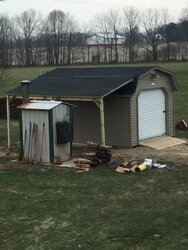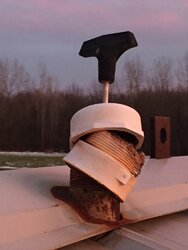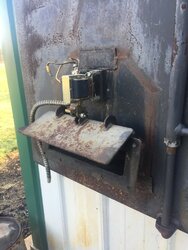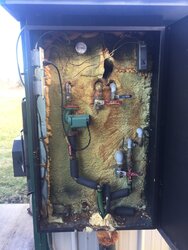I purchased a home this fall that included an outdoor wood boiler. The previous owner said it was a homemade unit (modeled after a central boiler) installed when the home was built, 14 years ago.
The boiler seems to be in great shape overall, but I could use some help fixing a few problems.
First, that gasket on the door is totally deteriorated. I found new gasket material in the basement. do i just tack it on with a high temp adhesive?
Second, there is a metal pipe sticking out through the roof to fill the water jacket. It had been previously capped with PVC, but it’s completely melted. There is also some sort of dipstick in the melted cap. Do I just replace it with a metal cap? Does it need to be vented? What’s with the dipstick?
Lastly, when I turn the unit on, there is some sort of actuator that opens and closes a baffle on the door. It doesn’t seem to close all of the way and makes an awful electrical buzzing noise you can hear all the way from the house. I assume that’s not normal, but what is the proper operation supposed to look like?
The boiler seems to be in great shape overall, but I could use some help fixing a few problems.
First, that gasket on the door is totally deteriorated. I found new gasket material in the basement. do i just tack it on with a high temp adhesive?
Second, there is a metal pipe sticking out through the roof to fill the water jacket. It had been previously capped with PVC, but it’s completely melted. There is also some sort of dipstick in the melted cap. Do I just replace it with a metal cap? Does it need to be vented? What’s with the dipstick?
Lastly, when I turn the unit on, there is some sort of actuator that opens and closes a baffle on the door. It doesn’t seem to close all of the way and makes an awful electrical buzzing noise you can hear all the way from the house. I assume that’s not normal, but what is the proper operation supposed to look like?





